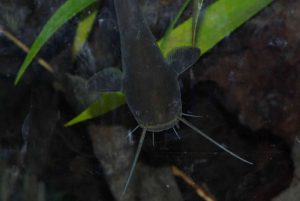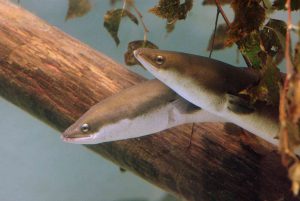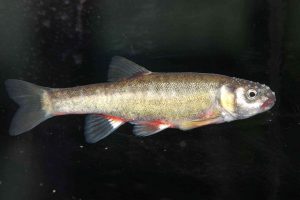Spawning Fishery
The “Gangfisch” (Coregonus macrophthalmus)- spawning fishery opened on December 4th, 2017. In total, 83 fishermen harvested 1’619 L of spawn during 5 nights and brought it to the six hatcheries around Lake Constance. The “Blaufelchen” (Coregonus wartmanni)- spawning fishery was opened December 9-12th 2017, and only 62 fishermen participated. Due to stormy weather conditions, they brought a reduced amount of spawn (1’358 L) into the hatcheries.

Fish of the year 2018
Every year, Austria, Switzerland, Germany, and Liechtenstein each separately choose a fish of the year. The selection is usually based on their conservation status. A fish may be selected for additional criteria, such as an extraordinary life history or a remarkable behavior. For the year 2018, the following species have been chosen:
Austria: Catfish (Silurus glanis)
The European Catfish is native to the watershed of Lake Constance, where the species is not threatened. On the contrary, it is increasing in population size within Lake Constance due to global warming. The catfish is very adaptable in its behavior and diet. In addition to pike and roach, professional fisherman increasingly target catfish due to a decline in whitefish and perch, which are more profitable species. Catfish is usually sold fresh or smoked.

Switzerland: European eel (Anguilla anguilla)
The European eel has a very special life cycle. The adults cross the Atlantic (more than 6’000 km) to reach the Sargasso Sea for spawning. As Leptocephalus larvae, the freshly hatched eels migrate back to Europe by swimming and drifting with the Gulf stream. This journey takes up to two years. Once they enter the fresh water habitats, the Leptocephalus larvae transform into Glass eels and start swimming upstream. They manage to overcome most obstacles, and they can even propel themselves over wet grass to reach upstream headwaters. The European eel is the only fish species to overcome the Rhine Falls.
The stocks of the European eel have collapsed due to dams and hydroelectric power plants. In the High Rhine between Lake Constance and Basel, the eels have to pass 11 hydroelectric power plants on their way upstream and back downstream. The passage downstream through the turbines is especially problematic and is usually fatal for an adult eel. The Federal Office for the Environment (FOEN) estimates that, out of more than 90’000 European eels swimming downstream the Upper Rhine, under 10 % make it to the French border.

Germany: Three-spined stickleback (Gasterosteus aculeatus)
The three-spined stickleback is a small fish species with a characteristic appearance and a unique behavior during mating season. The male builds a nest in the littoral zone out of plants and algae. It then attracts the female with specific swimming patterns. The male takes care of the brood while the female leaves the nest after egg deposition. The first occurrence of three-spined stickleback in Lake Constance was about 80 years ago. Until 2012, it colonized mainly littoral zones. Since 2013, it has spread into the whole pelagic zone and currently is the most common fish species in the open waters of Lake Constance by far. Three-spined stickleback competes with the whitefish for food and even preys on the larvae and juveniles of perch and whitefish.

Liechtenstein: minnow (Phoxinus phoxinus)
The minnow inhabits mainly rivers of the trout and grayling region. A few decades ago, it was a common species in most of Liechtenstein’s water bodies, but it is now rare. The minnow lives in oxygen-rich and unpolluted waters where it prefers the gravelly and sandy areas. Elderly individuals preferably stay in pools or covered areas, near riverbanks, and younger individuals also stay in shallow waters. The minnow tolerates various water temperatures but has strict requirements concerning the spawning substrate.
 [:]
[:]
